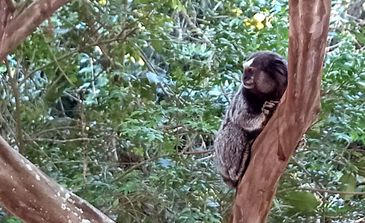“These are species that were brought by some human influence, to an area where they did not occur naturally. And this does not depend on political borders. That's why we say that the species may be native somewhere in Brazil, but it is invasive and causes problems in another ecosystem where it is not native.", Explain Silvia Ziller, founder of the institute, a non-governmental organization that has been monitoring invasive species in the country for almost 20 years.
ADVERTISING
It is the case of pirarucu (arapaima gigas), which had specimens taken from the Amazon region, where it is native, for aquarium farming, aquaculture and sport fishing. The giant fish spread throughout rivers and lakes in states such as Bahia, Piauí and São Paulo, according to the Horus Institute database.

There are also situations like that of marmosets (Callithrix sp.), small primates raised as domestic animals. The black-tufted marmoset (C. penicillata), originating from the cerrado, and the white-tufted marmoset (C. jacchus), from the caatinga, for example, ended up included in the Atlantic Forest.
These species compete with tamarins native to the Atlantic biome and hybridize with some congeners, such as the dusky marmoset (C. aurita), threatened with extinction. And, to make things even more complicated, the hybrids generated by these interactions between different marmosets are also considered invasive, occupying niches of other species and transmitting diseases to other animals.
ADVERTISING
Endemic to remnants of the Atlantic Forest in southern Bahia, the golden-faced lion tamarin (Leontopithecus chrysomelas), from the same family as marmosets, is a species considered in danger of extinction by the Red Book of Brazilian Fauna 2018. It has already been extinct from Minas Gerais.
Still, it was brought to Rio de Janeiro and improperly released in the Serra da Tiririca State Park, where it began to spread. The risk is that the animal reaches the areas where the golden lion tamarin occurs (Leontopithecus rosalia), a congener also threatened and with an even smaller population than the Bahian species.
Another curious case is that of the Brazilian water tiger turtle (Trachemys dorbigni), native to Rio Grande do Sul. The chelonian species suffered from undue release into the wild and the consequent invasion of its North American congener (Trachemys scripta), currently banned in Brazil. But it went from being a victim of the invasion to an invasive animal, when it was taken as a pet to other states and also released improperly in these places, where it began to prey on native species, transmit diseases and compete for space with local chelonians.
ADVERTISING
In the Serra do Tabuleiro State Park, in Santa Catarina, for example, it competes with the gray barbelled turtle (Phrynops hilarii). A study carried out at the site from 2019 to 2020, by biologist Lucas de Souza, at the time a student at the Federal University of Santa Catarina (UFSC), showed that captures of water tigers in the conservation unit were more frequent than those of terrapins , which may signal that the invasive species has come to predominate in the environment to the detriment of the native one.
A Agency Brazil tried to hear from the Ministry of the Environment and the Brazilian Institute of the Environment and Renewable Natural Resources (Ibama) about strategies to deal with invasive alien species, but received no response.
(With Brazil Agency)
Read also
* The text of this article was partially generated by artificial intelligence tools, state-of-the-art language models that assist in the preparation, review, translation and summarization of texts. Text entries were created by the Curto News and responses from AI tools were used to improve the final content.
It is important to highlight that AI tools are just tools, and the final responsibility for the published content lies with the Curto News. By using these tools responsibly and ethically, our objective is to expand communication possibilities and democratize access to quality information. 🤖
ADVERTISING





